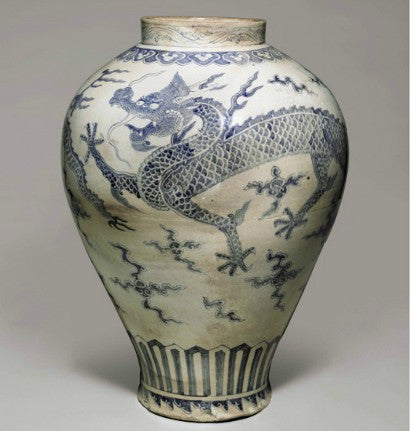Christie's launched its Asia week sales in New York yesterday (September 11) with an auction of Japanese and Korean Art, which was topped by a blue and white porcelain dragon jar.
 Dragon designs are only found on the rarest and most desirable pieces |
The piece originates from the Joseon dynasty (1392-1897), which was the last dynasty in Korean history and also the longest-ruling Confucian era.
The dragon jar was created in the 18th century and expressively painted with two five-clawed dragons chasing flaming pearls. Vessels such as the example at auction were popular in Korea from the 17th century through to the 19th century, though the majority feature floral designs.
Only the rarest and most desirable jars boast depictions of dragons. This piece was almost certainly commissioned by the royal court and is among the largest and most spectacular known. The jar's estimate was only available on request from Christie's, but it soon soared to $3.2m as top lot of the auction.
More spectacular results were seen by a 1962 oil painting from Park Sookeun, entitled Tree and Three Figures. Brought to auction from a private American collection, the simplistic piece depicts three women wearing traditional Korean clothing beneath a large, barren tree. A characteristic example of Park Sookeun's unassuming style, it crushed its $800,000 high estimate to achieve $1.9m.
Japanese art was represented by an early 17th century triptych from Hasegawa Tonin. Egrets and Ducks in a Winter Landscape began life as six sliding doors in Akashi Castle, Kobe. Now mounted as three two-panel screens, the stunning work sold for $626,500 - a 108.8% increase on its $300,000 valuation.
Elsewhere in New York, Bonhams' Himalayan, Indian and Southeast Asian Art sale saw The Eilenberg Buddha, a magnificent piece from Thailand's Mon Dvaravati culture, achieve a 92.7% increase.
Paul Fraser Collectibles will be bringing you more of the latest from Asia week soon, so be sure to check back with us regularly. For a weekly round-up of the top stories from auction houses across the globe, sign up to our free weekly newsletter.






